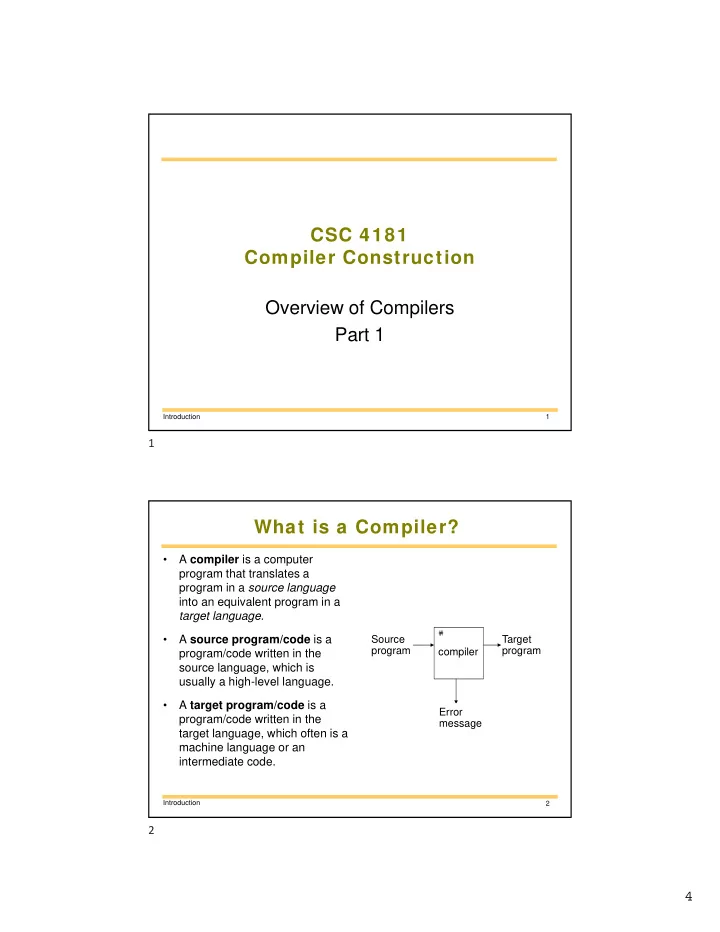

CSC 4181 Compiler Construction Overview of Compilers Part 1 Introduction 1 1 What is a Compiler? • A compiler is a computer program that translates a program in a source language into an equivalent program in a target language . � � • A source program/code is a Source Target program program compiler program/code written in the source language, which is usually a high-level language. • A target program/code is a Error program/code written in the message target language, which often is a machine language or an intermediate code. Introduction 2 2 �
Process of Compiling � � � � � �� � � � � � � � � � � � � � scanner � � � � � �� � � � � � � � � � parser � � � � � � � � � � � � � � � � � Semantic analyzer �� � � � � � � � � � � � � Intermediate code generator � � � � � �� � � � � � � � � � � Code optimization � � � � � �� � � � � � � � � � � Code generator � � � � � � � � � � � Code optimization � � � � � � � � � � � Introduction 3 3 Scanning • A scanner reads a stream of characters and puts them together into some meaningful (with respect to the source language) units called tokens . • It produces a stream of tokens for the next phase of compiler. Introduction 4 4 �
Parsing • A parser gets a stream of tokens from the scanner, and determines if the syntax (structure) of the program is correct according to the (context-free) grammar of the source language. • Then, it produces a data structure, called a parse tree or an abstract syntax tree , which describes the syntactic structure of the program. Introduction 5 5 Semantic analysis • It gets the parse tree from the parser together with information about some syntactic elements • It determines if the semantics or meaning of the program is correct. • This part deals with static semantic . – semantic of programs that can be checked by reading off from the program only. – s yntax of the language which cannot be described in context-free grammar . • Mostly, a semantic analyzer does type checking. • It modifies the parse tree in order to get that (static) semantically correct code. Introduction 6 6 �
Intermediate code generation • An intermediate code generator – takes a parse tree from the semantic analyzer – generates a program in the intermediate language. • In some compilers, a source program is translated into an intermediate code first and then the intermediate code is translated into the target language. • In other compilers, a source program is translated directly into the target language. Introduction 7 7 Intermediate code generation (cont’d) • Using intermediate code is beneficial when compilers which translates a single source language to many target languages are required. – The front-end of a compiler – scanner to intermediate code generator – can be used for every compilers. – Different back-ends – code optimizer and code generator – is required for each target language. • One of the popular intermediate code is three-address code . A three-address code instruction is in the form of x = y op z . Introduction 8 8 �
Code optimization • Replacing an inefficient sequence of instructions with a better sequence of instructions. • Sometimes called code improvement. • Code optimization can be done: – after semantic analyzing • performed on a parse tree – after intermediate code generation • performed on a intermediate code – after code generation • performed on a target code Introduction 9 9 Code generation • A code generator – takes either an intermediate code or a parse tree – produces a target program. Introduction 10 10 �
Recommend
More recommend